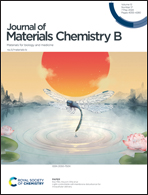Tracking the effects of PLGA-based nanoparticles on protein expression in living cells through quantitative proteomics†
Abstract
Mass spectrometry (MS)-based proteomics can identify and quantify the differential abundance of expressed proteins in parallel, and bottom-up proteomic approaches are even approaching comprehensive coverage of the complex eukaryotic proteome. Protein–nanoparticle (NP) interactions have been extensively studied owing to their importance in biological applications and nanotoxicology. However, the proteome-level effects of NPs on cells have received little attention, although changes in protein abundance can reflect the direct effects of nanocarriers on protein expression. Herein, we investigated the effect of PLGA-based NPs on protein expression in HepG2 cells using a label-free quantitative proteomics approach with data independent acquisition (DIA). The percentage of two-fold change in the protein expression of cells treated with PLGA-based NPs was less than 10.15% during a 6 hour observation period. Among the changed proteins, we found that dynamic proteins involved in cell division, localization, and transport are more likely to be more susceptible to PLGA-based NPs.



 Please wait while we load your content...
Please wait while we load your content...